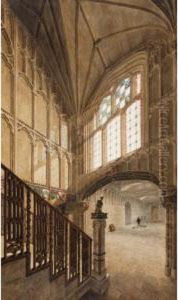Thomas Willement Paintings
Thomas Willement was an influential figure in the Gothic Revival movement in England, particularly noted for his work in stained glass. Born in 1786, his career spanned much of the 19th century, a period that saw a resurgence of interest in medieval art and architecture. Willement's work and expertise in stained glass played a significant role in the revival of this art form, which had been largely neglected since the Reformation. His contributions helped to rekindle appreciation for the complexity and beauty of medieval stained glass, making him a pivotal figure in Victorian art and design.
Willement's career began in earnest in the early 19th century, and he quickly established himself as a leading designer and manufacturer of stained glass. His reputation was built on his meticulous attention to detail and his ability to blend historical accuracy with artistic creativity. He was known for his extensive research into medieval stained glass techniques and patterns, which he then adapted to suit the tastes and sensibilities of his time. This approach not only endeared him to clients but also contributed to the broader Gothic Revival movement, influencing both contemporaries and future generations of artists and craftsmen.
In addition to his work on new projects, Willement was also deeply involved in the restoration of medieval stained glass, contributing to the preservation of England's architectural heritage. He was commissioned to work on stained glass for some of the most significant Gothic Revival projects of the time, including churches, cathedrals, and even private residences. His work is characterized by vibrant colors, intricate designs, and a deep respect for the traditions of the past.
Thomas Willement's legacy extends beyond his stained glass creations. He was an early advocate for the conservation of historic artworks and buildings, a stance that was relatively rare in his time. His dedication to his craft and his influence on the Gothic Revival movement left an indelible mark on the artistic landscape of 19th-century Britain. Willement passed away in 1871, but his work continues to be celebrated for its beauty, craftsmanship, and historical significance.


